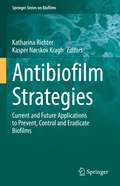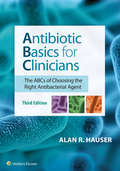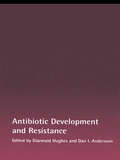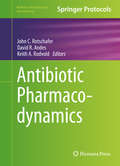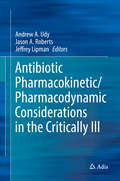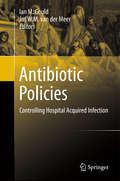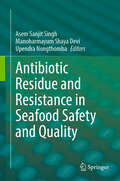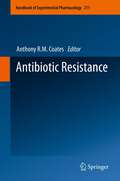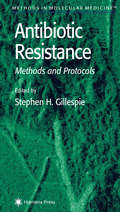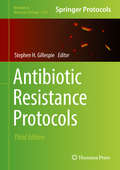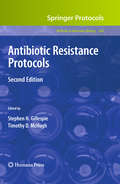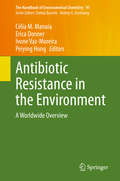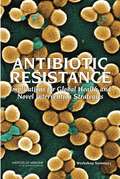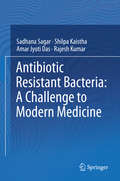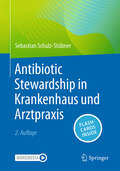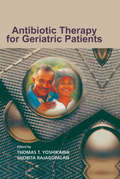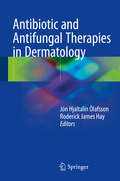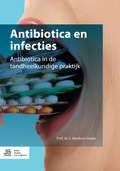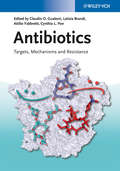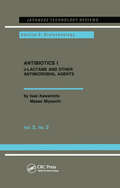- Table View
- List View
Antibiofilm Strategies: Current and Future Applications to Prevent, Control and Eradicate Biofilms (Springer Series on Biofilms #11)
by Katharina Richter Kasper Nørskov KraghBacteria and fungi are able to aggregate together or on surfaces in densely packed microcolonies, facilitated by extracellular polymeric substances for cell protection and stability. These biofilms have proven to be extremely hard to eradicate and remove once established. In chronic infections, this condition can result in a high degree of morbidity and mortality as regular antibiotic treatments are ineffective against biofilms. In industrial facilities, the formation of biofilms can ruin production and result in enormous financial losses. In this book, the current state of antibiofilm research is presented by experts from around the world. Novel, cutting-edge techniques and new optimized strategies based on established methods are discussed in chapters focused on biofilm prevention, treatment and control for the application in clinical, industrial and veterinary settings. Antibiofilm strategies, such as chemical and enzymatic treatments, surface modification and coatings, quorum sensing inhibition and dispersal induction, phage therapy, cold plasma treatment, hyperbaric oxygen treatment, and metal-based nanomedicine are covered, among many others. This book contributes to the UN’s Sustainable Development Goal 3: Good Health and Well-Being and is a valuable resource for healthcare professionals, microbiologists, academics and for educators to inform curricula of universities and colleges.
Antibiotic Basics for Clinicians: The Abcs Of Choosing The Right Antibacterial Agent (Point (lippincott Williams And Wilkins) Ser.)
by Alan HauserPublisher's Note: Products purchased from 3rd Party sellers are not guaranteed by the Publisher for quality, authenticity, or access to any online entitlements included with the product. Popular as a classroom text, for review, and as a clinical quick-reference, this time-saving resource helps medical students master the rationale behind antibiotic selection for common bacterial pathogens and infectious diseases. Updated content reflects the latest antibiotic medications available on the market, and new full-color illustrations strengthen users’ understanding of the application of antibiotic drug treatment.
Antibiotic Development and Resistance
by Diarmaid Hughes Dan I. AnderssonThe increasing resistance of bacteria towards all current classes of antibiotics is now a serious health problem in both developed and developing countries. Antibiotic Development and Resistance presents 15 chapters that explore the medical issues raised by this development and review the relevant literature. The book begins by reviewing the global
Antibiotic Discovery and Development
by Michael J. Pucci Thomas J. DoughertyThis volume covers all aspects of the antibiotic discovery and development process through Phase II/III. The contributors, a group of highly experienced individuals in both academics and industry, include chapters on the need for new antibiotic compounds, strategies for screening for new antibiotics, sources of novel synthetic and natural antibiotics, discovery phases of lead development and optimization, and candidate compound nominations into development. Beyond discovery , the handbook will cover all of the studies to prepare for IND submission: Phase I (safety and dose ranging), progression to Phase II (efficacy), and Phase III (capturing desired initial indications). This book walks the reader through all aspects of the process, which has never been done before in a single reference. With the rise of antibiotic resistance and the increasing view that a crisis may be looming in infectious diseases, there are strong signs of renewed emphasis in antibiotic research. The purpose of the handbook is to offer a detailed overview of all aspects of the problem posed by antibiotic discovery and development.
Antibiotic Drug Resistance
by José‐Luis Capelo‐Martínez Gilberto IgrejasThis book presents a thorough and authoritative overview of the multifaceted field of antibiotic science – offering guidance to translate research into tools for prevention, diagnosis, and treatment of infectious diseases. Provides readers with knowledge about the broad field of drug resistance Offers guidance to translate research into tools for prevention, diagnosis, and treatment of infectious diseases Links strategies to analyze microbes to the development of new drugs, socioeconomic impacts to therapeutic strategies, and public policies to antibiotic-resistance-prevention strategies
Antibiotic Optimization: Concepts and Strategies in Clinical Practice (Infectious Disease And Therapy Ser. #Vol. 34)
by Jr. Robert C. Owens Paul G. Ambrose Charles H. NightingaleThis book focuses on topics ranging from the economics of drug-resistant infections and the management of antimicrobial use to new information on methods to optimize the selection, route of administration, dosing, and duration of antimicrobial therapies for common infections. In addition to offering ideas on studied programmatic approaches for judi
Antibiotic Pharmacodynamics (Methods in Pharmacology and Toxicology)
by Keith A. Rodvold John C. Rotschafer David R. AndesThis text offers state of the art contributions written by world renown experts which provide an extensive background on specific classes of antibiotics and summarize our understanding as to how these antibiotics might be optimally used in a clinical situation. The book explores pharmacodynamics methods for anti-infective agents, pharmacodynamics of antibacterial agents and non-antibacterial agents, as well as pharmacodynamic considerations and special populations. As part of the Methods in Pharmacology and Toxicology series, chapters include detailed insight and practical information for the lab. Comprehensive and cutting-edge, Antibiotic Pharmacodynamics serves as an ideal reference for scientists investigating advances in antibiotic pharmacodynamics now finding their way into the antibiotic development process used for licensing new antibiotics.
Antibiotic Pharmacokinetic/Pharmacodynamic Considerations in the Critically Ill
by Jeffrey Lipman Jason A. Roberts Andrew A. UdyThis book provides unique insights into the issues that drive modified dosing regimens for antibiotics in the critically ill. Leading international authors provide their commentary alongside a summary of existing evidence on how to effectively dose antibiotics. Severe infection frequently necessitates admission to the intensive care unit (ICU). Equally, nosocomial sepsis often complicates the clinical course in ICU. Early, appropriate application of antibiotic therapy remains a cornerstone of effective management. However, this is challenging in the critical care environment, given the significant changes in patient physiology and organ function frequently encountered. Being cognisant of these factors, prescribers need to consider modified dosing regimens, not only to ensure adequate drug exposure, and therefore the greatest chance of clinical cure, but also to avoid encouraging drug resistance.
Antibiotic Policies: Controlling Hospital Acquired Infection
by Ian M. Gould Jos W.M. MeerThe first book was on "Theory and Practice" of antibiotic stewardship in its broadest sense -the how to do it and the do's and don'ts. The second, on "Controlling resistance" was very much on the relationships between use and resistance and beginning to home in on the hospital as the main generator of resistance, but mainly looking at it from a disease/clinical perspective. The last 3 chapters on MRSA, ended where the 3rd book will take off. "Controlling HAI " will concentrate on specific MDR organisms highlighting their roles in the current pandemic of HAI and emphasizing that the big issue is not so much infection control but antibiotic control, in the same way that antibiotic over-reliance/ over-use has caused the problem in the first place. Up 'till now the emphasis for controlling MRSA, C diff and all the other MDROs has very much been on IC, which clearly isn't working. This book will gather all the evidence for the increasingly popular view that much more must be done in the area of antibiotic policies/ stewardship, especially when we are in danger of a "post antibiotic" era, due to a real shortage of new agents in the pipeline.
Antibiotic Residue and Resistance in Seafood Safety and Quality
by Asem Sanjit Singh Manoharmayum Shaya Devi Upendra NongthombaThis book embark explores the global antibiotic trends in seafood, and delves into the intricate interplay between antibiotic consumption and its ramifications within the seafood industry. The nuanced effects of processing techniques on antibiotic residue levels in seafood are investigated, elucidating the prevalence of antibiotics and their metabolites within these commodities. The book also peers into the microbial realm of seafood, revealing the intricacies of resistance mechanisms, prevalence rates, pathogenicity, and related phenomena. It then explores the antibiotic alternatives in aquatic environments, including the utilization of nanoparticles and plant extracts. Artificial intelligence integration and sensor development for antibiotic residue detection ensures quality assurance and consumer safety within the seafood industry, and has been well-covered in this volume. This edited volume is beneficial for graduate students in fisheries science, life sciences, animal biotechnology, zoology, and microbiology. This can be a reference material for fisheries professionals, scientific communities, researchers, and scholars as well, for navigating the global antibiotic trends in seafood.
Antibiotic Resistance (Handbook of Experimental Pharmacology #211)
by Anthony R.M. CoatesThis book describes antibiotic resistance amongst pathogenic bacteria. It starts with an overview of the erosion of the efficacy of antibiotics by resistance and the decrease in the rate of replacement of redundant compounds. The origins of antibiotic resistance are then described. It is proposed that there is a large bacterial resistome which is a collection of all resistance genes and their precursors in both pathogenic and non-pathogenic bacteria. Ongoing resistance surveillance programs are also discussed, together with the perspective of a clinical microbiologist. The book then turns to specific themes such as the most serious area of resistance in pathogens, namely in Gram-negative organisms. The role of combinations of antibiotics in combating resistance emergence is discussed, particularly in the tuberculosis field, and then the importance of non-multiplying and persistent bacteria which are phenotypically resistant to antibiotics and prolong the duration of therapy of antibiotics which leads to poor compliance and resistance emergence. The role of anti-microbial compounds in textiles is covered, with its potential to exacerbate the spread of resistance. Then, efflux pumps are discussed. The final chapter describes the compounds which are in late stage clinical development, illustrating the paucity of the antibiotic pipeline, especially for Gram-negative bacteria.
Antibiotic Resistance Methods and Protocols: Methods And Protocols (Methods in Molecular Medicine #48)
by Stephen H. GillespieStephen Gillespie and a panel of leading clinical and diagnostic microbiologists describe a series of detailed molecular and physical methods designed to study the growing problem of antibiotic resistance, as well as facilitate new antibiotic research programs for its effective redress. The techniques range widely from those that provide rapid diagnosis via DNA amplification and phage display, to those for plotting the transmission of resistant organisms and investigating their epidemiology. The methods are readily adaptable to a wide range of resistant bacterial organisms. Practical and wide-ranging, Antibiotic Resistance: Methods and Protocols provides a collection of indispensable techniques not only for illuminating the basic biology of antimicrobial resistance, but also for developing and implementing new diagnostic and epidemiological tools.
Antibiotic Resistance Protocols: Second Edition (Methods in Molecular Biology #1736)
by Stephen H. GillespieStephen Gillespie and a panel of leading clinical and diagnostic microbiologists describe a series of detailed molecular and physical methods designed to study the growing problems of anitbiotic resistance, as well as facilitate new antibiotic research programs for its effective redress. The techniques range widely from those that provide rapid diagnosis via DNA amplification and phase display, to those for plitting the transmission of resistant organisms and investigating their epidemiology. The methods are readily adaptable to a wide range of resistant bacterial organisms.
Antibiotic Resistance Protocols: Second Edition (Methods in Molecular Biology #642)
by Stephen H. Gillespie Timothy D. MchughSince the publication of the popular first edition, genomic methods have become more accessible, allowing antibiotic researchers to probe not only the sequence of antibiotic resistance determinants but the mechanism whereby they are expressed and regulated. That, in concert with array technology and an understanding of the importance of biofilms, has greatly expanded antibiotic resistance knowledge. In order to reflect the growing field, Antibiotic Resistance Protocols, Second Edition fully updates and builds upon its first edition with contributions from leading researchers. Beginning with chapters on epidemiology and population genetics, the book continues with sections covering genomics and gene expressions, fitness mutation and physiology, and the detection of resistance. Written in the highly successful Methods in Molecular BiologyTM series format, chapters include introductions to their respective topics, lists of the necessary materials and reagents, step-by-step, readily reproducible laboratory protocols, and notes on troubleshooting and avoiding known pitfalls. Authoritative and up-to-date, Antibiotic Resistance Protocols, Second Edition brings together examples of a diverse range of modern techniques applied in antibiotic research in order to best aid scientists in planning their own future research.
Antibiotic Resistance in the Environment: A Worldwide Overview (The Handbook of Environmental Chemistry #91)
by Célia M. Manaia Erica Donner Ivone Vaz-Moreira Peiying HongThis book provides a multidisciplinary review of antibiotic resistance and unravels the complex and interrelated roles of environmental sources, including pharmaceutical industry effluents, hospital and domestic effluents, wildlife and drinking water. Antibiotic resistance is a global public health issue in which the interface between humans, animals and the environment is particularly relevant. The contrasts seen across different environmental compartments and world regions, which are due to climate, social and policy differences, mean that this problem needs to be analyzed from a multi-geographic and multi-cultural angle. Bringing together contributions from researchers on different continents with expertise in antibiotic resistance in a range of different environmental compartments, the book offers a detailed reflection on the paths that make antibiotic resistance a global threat, and the state-of- the-art in antibiotic resistance surveillance and risk assessment in complex environmental matrices.
Antibiotic Resistance: Implications for Global Health and Novel Intervention Strategies - Workshop Summary
by Institute of Medicine of the National AcademiesYears of using, misusing, and overusing antibiotics and other antimicrobial drugs has led to the emergence of multidrug-resistant 'superbugs.' The IOM's Forum on Microbial Threats held a public workshop April 6-7 to discuss the nature and sources of drug-resistant pathogens, the implications for global health, and the strategies to lessen the current and future impact of these superbugs.
Antibiotic Resistant Bacteria: A Challenge to Modern Medicine
by Rajesh Kumar Amar Jyoti Das Sadhana Sagar Shilpa KaisthaThis book summarizes the emerging trends in the field of antibiotic resistance of various gram-negative and gram-positive bacterial species. The ability of different species of bacteria to resist the antimicrobial agent has become a global problem. As such, the book provides a comprehensive overview of the advances in our understanding of the origin and mechanism of resistance, discusses the modern concept of the biochemical and genetic basis of antibacterial resistance and highlights the clinical and economic implications of the increased prevalence of antimicrobial resistant pathogens and their ecotoxic effects. It also reviews various strategies to curtail the emergence and examines a number of innovative therapeutic approaches, such as CRISPR, phage therapy, nanoparticles and natural antimicrobials, to combat the spread of resistance.
Antibiotic Stewardship im Krankenhaus
by Sebastian Schulz-StübnerExpertenwissen zum rationalen Einsatz von Antiinfektiva im Krankenhaus ist unverzichtbar. Antibiotic Stewardship zur optimalen Behandlung von Infektionen und zur Bekämpfung von Antibiotikaresistenzen. Spezielle Strategien und ihre Umsetzung im Alltag zur Verbesserung der Patientensicherheit.Der Leitfaden für „Antibiotikabeauftragte Ärzte“ und die modularen Fortbildungen (fellow-, advanced- und expert-Kurs) zu „Antibiotic Stewardship“.Aus dem InhaltEpidemiologie, Bewertung von Resistenzstatistik und Antibiotikaverbrauch, Surveillancesysteme und BenchmarkingGesetzliche Grundlagen: Infektionsschutzgesetz, gesetzliche Qualitätssicherung, ArzneimittelrechtOralisierungsstrategien und Outpatient parenteral antibiotic therapy (OPAT), Dosisoptimierung und Therapeutisches Drugmonitoring (TDM)Diagnostic Stewardship, Bewertung mikrobiologischer BefundePerioperative Antibiotikaprophylaxe und InfektionsmanagementAntibiotikaprophylaxen bei Immunsuppression und chronischen KrankheitenDie wichtigsten Krankheitsbilder unter ABS-GesichtspunktenPädiatrische BesonderheitenEinbeziehung von Ärzten, Pflegenden, Patienten und Angehörigen. Entlass- und ÜberleitungsmanagementFallbeispiele aus der ABS-Beratung
Antibiotic Stewardship in Arztpraxis und Ambulanz
by Sebastian Schulz-StübnerExpertenwissen zum rationalen Einsatz von Antiinfektiva in Arztpraxis und Ambulanz ist unverzichtbar. Bekämpfung von Antibiotikaresistenzen. Spezielle Strategien und ihre Umsetzung im Alltag.Für jede Praxis und jedes ambulante OP-Zentrum, wo Antibiotika angewendet und verschrieben werden. Insbesondere für die Fortbildung zum „Antibiotikabeauftragten Arzt“.Aus dem InhaltEpidemiologie, Bewertung von Resistenzstatistik und Antibiotikaverbrauch, Surveillancesysteme und BenchmarkingGesetzliche Grundlagen: Infektionsschutzgesetz, gesetzliche Qualitätssicherung, ArzneimittelrechtOutpatient parenteral antibiotic therapy (OPAT), Dosisoptimierung und Therapeutisches Drugmonitoring (TDM)Diagnostik: Präanalytik und Probenversand, Point of Care Tests (POCT)Wann ist eine mikrobiologische Untersuchung erforderlich, Bewertung des BefundesDie wichtigsten Krankheitsbilder unter ABS-GesichtspunktenImpfungen, pädiatrische Besonderheiten, Antibiotika in Schwangerschaft und StillzeitEinbeziehung von Patienten und Angehörigen. Was ist zu tun, wenn der Patient aus der Klinik kommtChoosing wisely: Wann benötigen Sie keine Antibiotika in der Hausarztpraxis oder im ärztlichen NotfalldienstFallbeispiele aus der ABS-Beratung
Antibiotic Stewardship in Krankenhaus und Arztpraxis
by Sebastian Schulz-StübnerDieses Buch ist Lehrbuch und Nachschlagewerk in einem, wenn es um die praktische Umsetzung des „One Health-Konzeptes“ zur Bekämpfung von multiresistenten Krankheitserregern in Krankenhaus und Arztpraxis geht. An der praktischen Umsetzung orientiert fasst es die Inhalte der aktuellen Leitlinien zu rationalen Antiinfektivastrategien zusammen und verhilft so zur optimierten Behandlung von Infektionen, zur Bekämpfung von Antibiotikaresistenzen und zur Verbesserung der Patientensicherheit.Perfekt für „Antibiotikabeauftragte Ärzte“ und die strukturierte curriculare Fortbildung (fellow-, advanced- und expert-Kurs) zu „Antibiotic Stewardship“. Die 2. Auflage wurde komplett aktualisiert und ist auch für die Anwendung in der Arztpraxis gedacht.
Antibiotic Therapy for Geriatric Patients
by Thomas T. Yoshikawa Shobita RajagopalanWritten by leading authorities, this reference provides quick access to essential information on specific antibiotics, major clinical infections, selected pathogens, and infections in long-term elderly-care facilities. It summarizes an array of topics related to infectious diseases in older adults, including epidemiology, clinical manifestations, altered host resistance, and pharmacology. The authors detail the diagnosis, treatment, and prevention of major infections in the elderly, present up-to-date research on common pathogens that cause infections, and discuss modern procedures to avoid the spread of diseases such as influenza, pneumonia, herpes zoster, and hepatitis.
Antibiotic and Antifungal Therapies in Dermatology
by Jón Hjaltalín Ólafsson Roderick James HayThis book is an up-to-date practical guide to the treatment of both common and unusual bacterial, fungal, and protozoal skin infections. Antibiotics and other treatment options for common skin diseases such as acne, rosacea, erysipelas, and impetigo are extensively discussed, and a thorough update is provided on therapies for fungal infections in the nails, hair, and skin. Current treatments for skin symptoms associated with sexually transmitted diseases are also explored in detail. A range of mycobacterial infections are discussed, and a further chapter considers the treatment of protozoal infections, including leishmaniasis, which are often unfamiliar to practitioners in the Western world. This handy book, with its helpful graphics and clear lists of symptoms, treatments, and practical tips, will be an ideal quick reference for the busy practitioner.
Antibiotica en infecties: Antibiotica in de tandheelkundige praktijk
by L. Abraham-InpijnHet duel tussen antimicrobiële middelen en micro-organismen is er één datal jaren de wetenschap bezighoudt. Hierover werd in de zestiger jaren van devorige eeuw nog gezegd dat: 'in 2000 er geen infectieziekten meer zijn'. De strijd dreigt nu te eindigen met een overwinning door de micro-organismen. De negatieve spiraal die is ontstaan wordt onder meer versterkt door: overmatig en ondeskundige antibioticagebruik (zowel inde humane als veterinaire geneeskunde), gebrek aan innovatie met betrekking totnieuwe antimicrobiële middelen en de grote mobiliteit in vracht enpersonenvervoer. Dit alles naast vakantiereizen, immigratie, ongezondelevensomstandigheden en Dit boek gaat in op deveranderende visie ten aanzien van het gebruik van antibiotica. Welke oorzakenliggen hieraan ten grondslag en wat zijn de consequenties? Ook deindicaties waarover in de tandheelkunde nog discussies bestaan komen aande orde. Daarnaast biedt het een op de wetenschappelijke literatuur gefundeerdantwoord op praktische vragen over het gebruik van antibiotica in de tandheelkundigepraktijk. Antibiotica en infecties is een onmisbaar boek bij het gebruik vanantibiotica en profylaxe in de tandheelkunde. Deze uitgave is primairgeschreven voor tandartsen en overige (tandheelkundige) professionals die te maken krijgen met gebruik vanantibiotica in hun praktijk. De auteur prof. Dr. L. Abraham-Inpijn is emeritushoogleraar inwendige geneeskunde en algemene pathologie aan de faculteitgeneeskunde UvA, mede ten behoeve van de tandheelkunde. Tot op heden is zijverbonden aan de Divisie A (Interne Geneeskunde) van het Amsterdams MedischCentrum. Zij heeft verschillende publicaties op haar naam staan en schrijftregelmatig artikelen voor het vakblad voor de tandarts 'Tandartspraktijk'.
Antibiotics
by Cynthia L. Pon Attilio Fabbretti Claudio O. Gualerzi Letizia BrandiMost of the antibiotics now in use have been discovered more or less by chance, and their mechanisms of action have only been elucidated after their discovery. To meet the medical need for next-generation antibiotics, a more rational approach to antibiotic development is clearly needed.Opening with a general introduction about antimicrobial drugs, their targets and the problem of antibiotic resistance, this reference systematically covers currently known antibiotic classes, their molecular mechanisms and the targets on which they act. Novel targets such as cell signaling networks, riboswitches and bacterial chaperones are covered here, alongside the latest information on the molecular mechanisms of current blockbuster antibiotics. With its broad overview of current and future antibacterial drug development, this unique reference is essential reading for anyone involved in the development and therapeutic application of novel antibiotics.
Antibiotics I
by Isao KawamotoThis book reviews more recent studies of antibiotics in Japan. It describes β-lactams and other antimicrobial agents according to the following categories: parenteral cephems and related compounds, oral cephalosporins, penems and carbapenems, monobactams, aminoglycosides, and macrolides.
